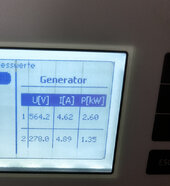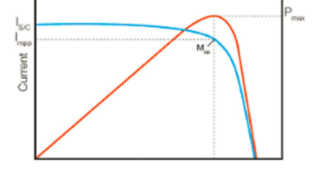You are using an out of date browser. It may not display this or other websites correctly.
You should upgrade or use an alternative browser.
You should upgrade or use an alternative browser.
Current and voltage : positive correlation?
- Thread starter skyman
- Start date
seneysolar
Solar Addict
Volts x Amps = Watts
Convert everything to watts when comparing loads and you'll get the idea.
Raising the voltage means LESS current is needed to get the same watts (power)
Convert everything to watts when comparing loads and you'll get the idea.
Raising the voltage means LESS current is needed to get the same watts (power)
hwy17
Anti-Solar Enthusiast
On a resistive load like a space heater or a charging battery, more voltage will drive more current.
On an inductive load like an AC motor, more voltage will result in less current.
The resistor increases its wattage exponentially by voltage. 2x voltage 4x power. The inductor wants to keep its wattage constant.
On an inductive load like an AC motor, more voltage will result in less current.
The resistor increases its wattage exponentially by voltage. 2x voltage 4x power. The inductor wants to keep its wattage constant.
What is the context of your question? Comparing PV panels maybe?Does more voltage mean automatically more generated current ?
Thx but that doesn’t answer my question :Volts x Amps = Watts
Convert everything to watts when comparing loads and you'll get the idea.
Raising the voltage means LESS current is needed to get the same watts (power)
I have two strings, one string has 10 panels and the other has 20 panels. The panels are the same and have the same specs.
By looking at the output of each string, I notice that the bigger string ( that has more panels ) has a higher voltage but less current than the smaller string, do you have an idea what could be the reason for this ?
Attachments
Please look at my reply to &seneysolarWhat is the context of your question? Comparing PV panels maybe?
I hope you could give some useful tips on this
Thx
hwy17
Anti-Solar Enthusiast
Edit: I re-thought it through and the mppt is probably finding different current power points for the two strings. It looks like it's working ok.Thx but that doesn’t answer my question :
I have two strings, one string has 10 panels and the other has 20 panels. The panels are the same and have the same specs.
By looking at the output of each string, I notice that the bigger string ( that has more panels ) has a higher voltage but less current than the smaller string, do you have an idea what could be the reason for this ?
That is a minor performance difference without an obvious explanation. Shading maybe, but they're probably not shaded.
In this comparison, 1 string of 10 in series, vs. 1 string in 20 in series, if the panels are all identical you would expect the voltage to be different and the current to be the same.
Well your previous explanation isn’t quite wrong :
Both strings are connected in series, and the bigger one has quite longer wires than the smaller one !
hwy17
Anti-Solar Enthusiast
Yeah, but I had to re-think that all through, because wire distance would actually affect voltage, not current, I realized.Well your previous explanation isn’t quite wrong :
Both strings are connected in series, and the bigger one has quite longer wires as the smaller one !
And then I realized that there is an MPPT involved, so we are not just dealing with electrical properties, but a variable algorithm operating within other constraints as well.
All together, it looks fine. I'm just a little scared for your MPPT with 20 panels in series. Hopefully that's within it's voltage limitations (1000v?).
No!
The smaller string lays approx 3 meters below the bigger one !
Yeah, but I had to re-think that all through, because wire distance would actually affect voltage, not current, I realized.
And then I realized that there is an MPPT involved, so we are not just dealing with electrical properties, but a variable algorithm operating within other constraints as well.
All together, it looks fine. I'm just a little scared for your MPPT with 20 panels in series. Hopefully that's within it's voltage limitations (1000v?).
but why should the MPPT reduce the current ? Isn’t that counter-productive ?
The string that has 20 panels has a max VOC 620 volt while the smaller one has 320 volt, so in total 940 volt
Oy... I ticked a like your previous answer and then you changed itYeah, but I had to re-think that all through, because wire distance would actually affect voltage, not current, I realized.
Wire distance will be (marginally) more ohms, so reduce current.
hwy17
Anti-Solar Enthusiast
hwy17
Anti-Solar Enthusiast
Oh maybe I was right and I just didn't know it! Always gotta be on the defense in case someone's gonna come find a hole in my argument lol. They'll discover I'm an imposter!Wire distance will be (marginally) more ohms, so reduce current.
It should maximise power, whatever V x I will create max power...but why should the MPPT reduce the current ? Isn’t that counter-productive ?
But 620V is very high... what is the range of the MPPT of your inverter, maybe the voltage is above the MPPT tracking range, resulting in the sub-optimal power?
The mppt is kind of feeling in the dark for the power point, and at some point it settles for good enough. It doesn't always find the mpp exactly.
View attachment 200238
Ok,Oh maybe I was right and I just didn't know it! Always gotta be on the defense in case someone's gonna come find a hole in my argument lol. They'll discover I'm an imposter!
I have an additional question for you :
Is it safe to measure string’s current while the inverter is running with clamp meter ( measuring current at the inverter’s DC input with clamp meter ) ?
So longer wires means automatically lower ohms resistance ? If we measure insulation resistance we expect higher resistance at the smaller string than the bigger one, right?Oy... I ticked a like your previous answer and then you changed it
Wire distance will be (marginally) more ohms, so reduce current.
MPPT tracker range 350-800But 620V is very high... what is the range of the MPPT of your inverter, maybe the voltage is above the MPPT tracking range, resulting in the sub-optimal power?
hwy17
Anti-Solar Enthusiast
If you have a DC clamp meter and can do so without risking touching the live parts, yesIs it safe to measure string’s current while the inverter is running with clamp meter ( measuring current at the inverter’s DC input with clamp meter ) ?
Similar threads
- Replies
- 3
- Views
- 186
- Replies
- 30
- Views
- 1K
- Replies
- 36
- Views
- 909




